Hearty turnout for defibrillator launch |
|
| Cleveleys Masonic Hall was the launch site chosen for the roll out of a programme to ensure that every Masonic hall in the Province of West Lancashire has a heart defibrillator in place against the day that the machine will be required in an emergency. The scheme has been so well received that 67 brethren, representing 24 lodges from throughout the Fylde attended the presentation. | |
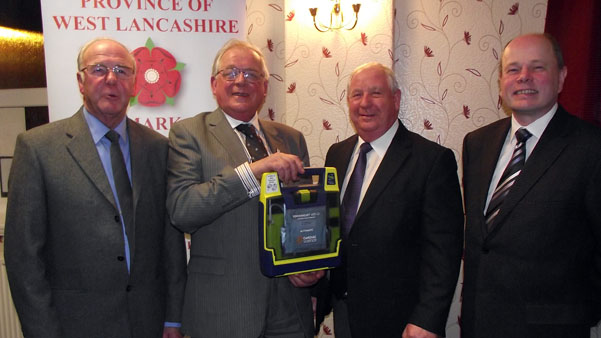 |
|
Pictured from left to right at the presentation of the defibrillator at Cleveleys are Eric Peat, |
|
Peter Connolly, Harry Cox and Duncan Smith. |
|
| These brethren were welcomed to Cleveleys by hall chairman Eric Peat who in turn introduced Peter Connolly the PrGM of the Provincial Grand Lodge of Mark Master Masons of West Lancashire which has provided defibrillators for halls which previously did not have them. Peter spoke of his great delight that so many Masons had turned out to learn about the ease of operating the defibrillators – humorously acknowledging that the many visitors to Cleveleys had not just come to see him in action. | |
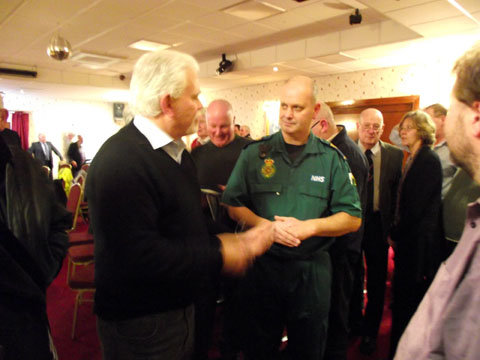 |
|
David Randerson has a chat to Chris Veevers about the merits of defibrillators. |
|
| Peter welcomed Craft APrGM Harry Cox, Assistant to the Provincial Grand Principals for the Royal Arch David Randerson, North Fylde Group Chairman Duncan Smith, Provincial Masonic Halls’ Coordinator Tony Hough and his own Deputy PrGM Keith Beardmore. | |
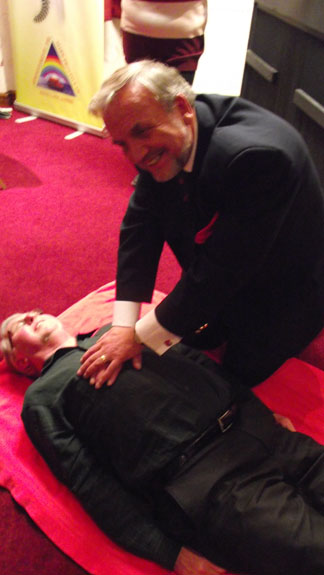 John Forster tries out his version of CPR on a ‘volunteer’. |
|
| Peter acknowledged the enormous amount of work his APrGM Michael Clarke had undertaken in coordinating the various aspects of the defibrillator programme. Research by the Provincial Grand Lodge of Mark Master Masons showed that though some halls had a defibrillator already on site, 18 halls were without the vital equipment. Halls throughout the Province without defibrillators were identified, orders placed, and it was decided to stage the first training session at Cleveleys with other halls coming on stream in the following weeks. | |
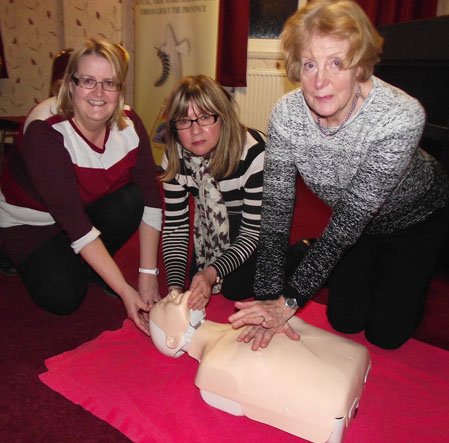 |
|
Dummy run - Helen demonstrates cpr |
|
| Peter announced that he had another very pleasant task to perform before getting to the main business of the evening. He said that Peter Clay the WM of Cleveleys Park Lodge No 7540 had recently had to have two cardiovascular procedures at Blackpool Victoria Hospital, which involved the use of a defibrillator to put his heart into a regular rhythm. | |
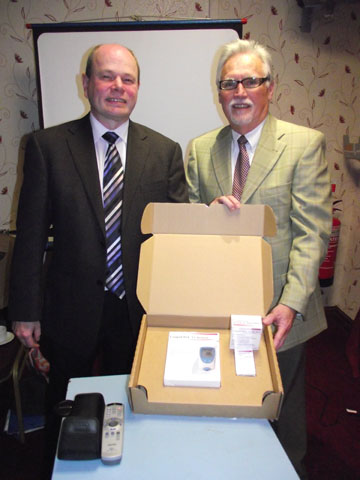 |
|
Duncan Smith (left) and Peter Clay show off the Roche Coaguchek machine to be presented to |
|
Blackpool Victoria Hospital. |
|
| During the follow up treatment which Peter received to monitor his progress he discovered that the BVH Cardiac Unit had only one hand held Roche Coaguchek machine to treat an average of 90 patients per day. As the rate of checking takes six to eight minutes per patient it meant that the waiting time could be very long for some patients. Peter consequently appealed to the lodges meeting in the North Fylde Group to contribute to a fund to purchase a second Roche machine. | |
| This appeal was brought to the attention of Peter Connolly and, as a result, the charitable arm of the Mark degree swung into action to purchase a second machine which, with the necessary slides, costs in the region of £500. The PrGM presented his namesake Peter with a cheque for the amount required and announced that Mark Masonry would match-fund any amount raised by the North Fylde Group which will go towards the purchase of a third machine. | |
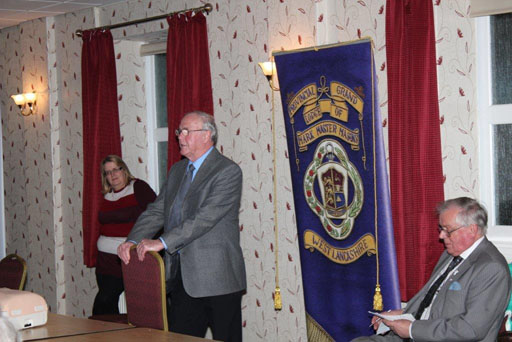 |
|
Eric Peat thanks Peter Connolly and the Mark Charities |
|
| Thanking the PrGM for his very generous offer, Peter Clay said that he would be presenting the Coaguchek machine, which he has already acquired, to BVH during the following week. See the Story here. | |
| Peter then invited NHS paramedic Chris Veevers from the Resuscitation Council and his wife Helen to explain about the life saving properties of heart defibrillators. | |
| Chris, who is himself a Mason, runs courses on the use of the machines throughout the Fylde. He told his packed audience (whom he later complimented on being the largest group he has ever had to address), that he would be giving them basic training on the simple-to-use defibrillators. | |
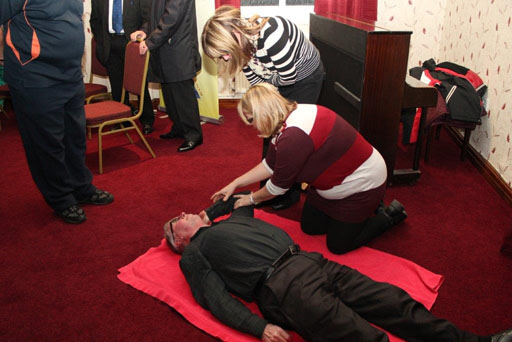 |
|
Helen Veevers shows some ladies how to use the recovery position. |
|
| He emphasised that though the machines were life savers they were essentially a first aid device and that the first action any Mason should take when confronted with a person suffering from a life threatening situation was to call 999 which would set the paramedics on their way. That said, statistics showed that the presence of a defibrillator versus its non availability, something in the order of 60% of lives were saved through its use. | |
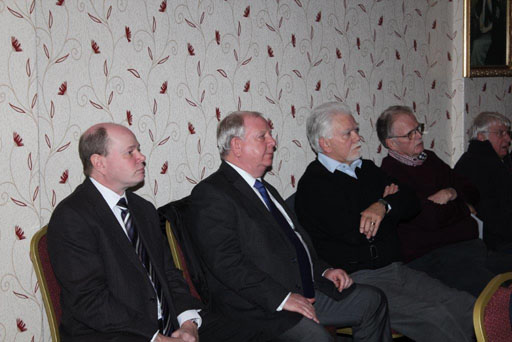 |
|
All listen carefully, we should be safe in their hands! |
|
| He said how delighted he was that defibrillators were now being installed not only in every Masonic hall but in public buildings everywhere throughout the country as authorities recognised the valuable asset the machines are. | |
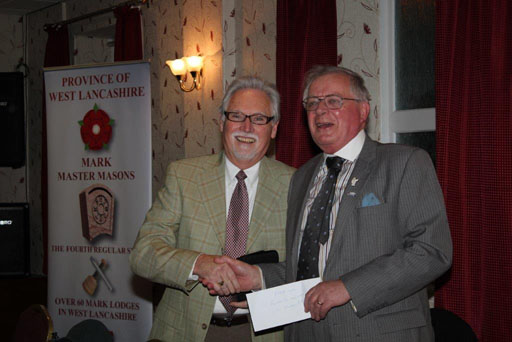 |
|
The two Peters |
|
| Chris went through some examples of real life situations he had experienced in his work as a paramedic; placing emphasis on the basic precept that first person arriving on a scene where someone had suffered a heart attack could make the difference between life and death in the first vital minutes. | |
| He explained to his audience about the tell tale signs to look for, coaxing audience participation for examples such as chest pain, skin pallor and breathing problems. He also advised on recognising the differences between someone experiencing a heart attack or suffering from cardiac arrest. | |
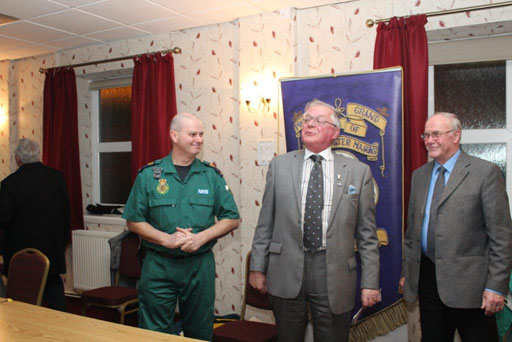 |
|
Peter thanks Chris for his input |
|
| Using the example of an orchestra he compared the various sections of the orchestra with the muscles and valves of the heart and how if one area stalled the rest got out of sync causing a ripple effect and eventual shut down. The electric charge the defibrillator delivered shocked the heart into restarting and to work rhythmically and in harmony with its other component parts. | |
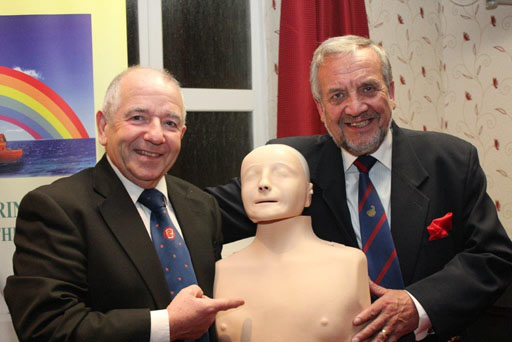 |
|
Keith Beardmore and John Forster discuss the evening's events with star of the night |
|
| Chris demonstrated the use of the defibrillator which, once activated, gives audible, clear, foolproof, step by step instructions on its use. The machine also comes with a cache of equipment ranging from spare electronic pads to plastic gloves, scissors and even a razor (for use on hairy chests). | |
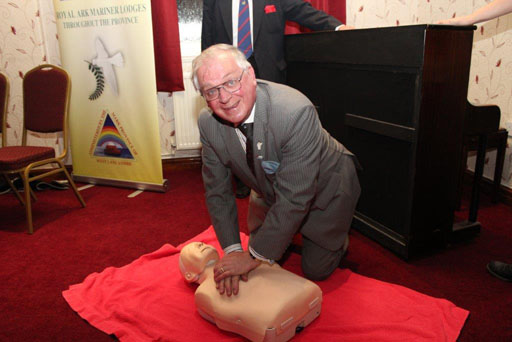 |
|
The PGM proves he was listening |
|
| Following his presentation Chris and Helen then put the brethren, as well as a few of their ladies who had also come along to the training session, through their paces giving them the opportunity to try out the defibrillator and to test their CPR skills out on a mannequin ‘patient’. | |
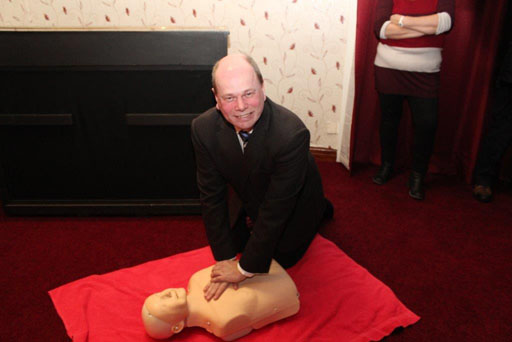 |
|
and Duncan Smith is not going to be outdone! |
|
| At the end of the presentation Peter thanked Chris and Helen for the invaluable part they had played in the evening and asked the brethren to show their appreciation with a ‘hearty’ round of applause. | |
| Article by Bob Boal with photographs by Bob and Giles Berkley | |
